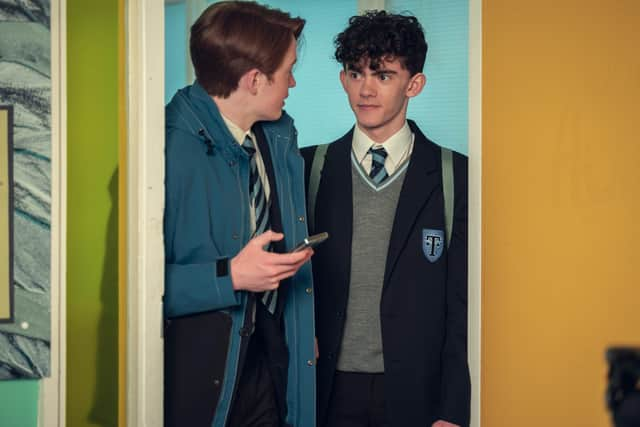Heartstopper review: Netflix’s sweet coming-of-age romance is the most likeable show of the year
and live on Freeview channel 276
Heartstopper is probably the most immediately likeable new television show of the year so far.
A lot of that is tonal: it’s a very pleasant, very endearing piece of television, easy to enjoy and difficult to be cynical about. Heartstopper is upbeat and gentle, full of sunlight and bright colours, with a welcome lightness of touch that sets it apart from others of its genre. Maybe the best way to describe its general vibe is to say that it’s a very inviting series – it’s nice, in the most earnest and least dismissive sense of the word. Most importantly, though, it’s in possession of one of the most elusive, hard-to-define-but-easy-to-notice qualities a television show can have: it’s very, very watchable.
Advertisement
Hide AdAdvertisement
Hide AdThe Netflix series is a coming-of-age romance between Nick (Kit Connor) and Charlie (Joe Locke), two teenagers at an all-boys school, adapted by YA author Alice Oseman from their graphic novels of the same name. One thing that’s immediately very striking about Heartstopper – palpable even if you’re not familiar with the source material – is how much creative control Oseman clearly had on the series. There’s a real clarity of adaptation here, offering probably one the most direct translations from page to screen ever; there’s no concession to any kind of Americanism to note an obvious example (they’re quite pointedly not at a US high school in west Wales, like Netflix’s Sex Education), but even in more general terms, all of that gentle earnestness is filtered straight from the books.
The cast even look like the drawings, funnily enough, though you imagine that’s more of coincidence than anything else. They’re each, for the most part, first-time actors, which gives Heartstopper a kind of refreshingly unpolished feel – not in the sense that the performances aren’t fully-formed or that they’re tentative at all, but more that there’s something quite uninhibited and naturalistic about the series. It’s all in a register that gives Heartstopper’s world this very lived-in, very three-dimensional feel (as does an exhaustive attention to detail generally – there are lots of scenes where the characters are texting, for example, and in close-up shots of their phone screens you can see thought has been put into what their most recently used emojis would be).
It’d be difficult – and, really, unfair – to highlight any of the ensemble ahead of one another. Tobie Donovan and Kizzy Edgell have great comic timing; Sebastian Croft lends villain Ben a vulnerable intensity; William Gao has an obvious gift for physical comedy; Corinna Brown gives a performance with real warmth, and Yasmin Finney is remarkably poised and controlled throughout. Still, though, it’s Kit Connor and Joe Locke’s series in the end, their characters’ fumbling, sweetly cautious romance the spine of the series. They’ve got a great, very affectionate chemistry together, and the screen lights up whenever they’re together.


One thing that’s interesting about Heartstopper is how pointedly different it is from a lot of the shows it would otherwise be grouped with – the Euphorias, Sex Educations, and Riverdales of the world. Comparisons will abound, even if they’re probably not quite fair; Heartstopper is pitched at a much younger audience than any of those programmes, often feeling like something a teacher could quite happily play in a school PSCHE lesson, even as it has an obvious all-ages appeal. Really, it’s the best show CBBC never made, rather than something that’s meant to sit alongside efforts from the CW or HBO – but again, in the same sense that Heartstopper is nice in the most earnest and least dismissive sense of the word, calling it a good children’s show is a compliment. That’s a difficult thing to do right!
Advertisement
Hide AdAdvertisement
Hide AdAll of that said, though, it’s striking how – for all that the show is sweet and pleasant – it’s never saccharine or insubstantial. That lightness of touch belies a real certainty to how the show was written and directed, a fundamental surety and confidence in and of itself. Heartstopper is a show where the characters do all do ‘the right thing’ – they’re all very sensible, talking to their parents and their teachers and each other about their feelings – but it never feels like that’s at the expense of the drama. If anything, it’s probably dramatically richer for it, and likely more mature than a lot of its counterparts too; as the novels continue, they engage with things like eating disorders and self-harm, and you get the sense that in further series of the television show that ‘sensible’ approach might develop into something quietly radical in terms of the teen drama genre.
Ultimately, it’s very easy to get invested in Heartstopper. Part of that is just because it is, as noted, a really well-put together show; it’s comfortably Euros Lyn’s best directed work, a cut above his already impressive episodes of Doctor Who, Black Mirror, and Broadchurch. But mainly it’s because of how charming and endearing it is, the sort of programme that’ll win people over very quickly – that already very dedicated fanbase is about to get a lot bigger.
Heartstopper will arrive on Netflix on Friday 22 April; I’ve seen all eight episodes before writing this review. You can read our interview with Alice Oseman - discussing the process of adapting the novels, how the series compares to other teen drama, and more - right here.
Comment Guidelines
National World encourages reader discussion on our stories. User feedback, insights and back-and-forth exchanges add a rich layer of context to reporting. Please review our Community Guidelines before commenting.
